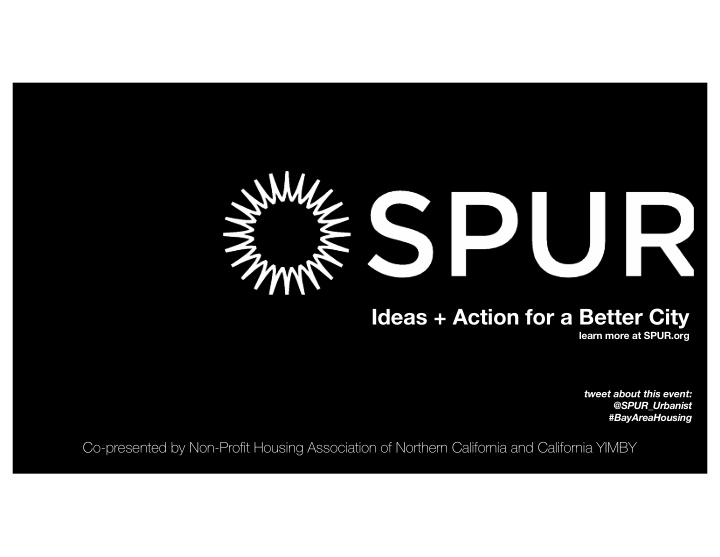



Ideas + Action for a Better City learn more at SPUR.org tweet about this event: @SPUR_Urbanist # BayAreaHousing Co-presented by Non-Profit Housing Association of Northern California and California YIMBY
Regional Housing Need Assessment/Allocation (RHNA) 101 California Department of Housing & Community Development Division of Housing Policy Development
Understanding RHNA RHNA is . . . A projection of additional housing units needed to accommodate projected household growth of all income levels from the start until the end date of the projection period. RHNA is not . . . ü A prediction of building permit, construction, or housing activity ü A ceiling of potential housing market demand or production ü Limited due to existing land use capacity or growth control (rezoning often necessary to accommodate RHNA) 2
The RHNA Process RHNA RHNA RHNA Distribution/ Determination/ ~1-2 years Planning Allocation Assessment COG develops RHNA Plan HCD HCD Reviews (New!) Determines (4-Multi County Regions w/ 23 Local RHNA Counties w/ 353 jurisdictions + Governments consulting with 15 Single-County COGs w/ (539 jurisdictions) 128 jurisdictions) DOF & COG (New Factors!) HCD acts as COG (20 Predominantly ~1 year Rural Counties w/ 58 jurisdictions) Housing COG DOF Elements and APRs ( HCD Reviews) 3
RHNA Determination Factors (HCD to COG) RHNA Determination Factors (DOF) Projected Population at end of cycle, less group quarters population (Demographic Research Unit). 1 2 (DOF) Convert Projected Population to Projected Households (HCD) Adjustment increase for average housing unit replacement, unhealthy vacancy rate (below 5%), jobs housing imbalance, cost burden and overcrowding factors 3 4 Less: Occupied Units Projection Period Start (DOF) 5 (HCD) RHNA Determination Very Low Low Income Moderate Above Moderate Income Income Income <50% Area Median 50-80% Area Median 80%-120% Area >120% Area Median Income Income Median Income Income Source: Government Code 65584.01 4
Statutory Objectives of RHNA • Increase housing supply & mix of housing types, tenure & affordability in an equitable manner • Promote infill development & socioeconomic equity, protect environmental & ag resources, & encourage efficient development patterns (the State “planning priorities”) • Promote improved intraregional jobs-housing relationship including jobs housing fit • Balance disproportionate household income distributions (more lower income RHNA to higher income areas and vice-versa) • Affirmatively furthering fair housing Source: Government Code 65584(d) 5
COG RHNA Distribution Methodology [GC 65584.04(d)] COG must consider these factors: 1. Existing and projected jobs and housing relationship 2. Housing opportunities and constraints (inadequate capacity of infrastructure/services) (availability of suitable land) (preserved/protected/prime agricultural land) 3. Distribution of household growth assumed for comparable period of RTP 4. County-city agreement to direct growth toward city 5. Loss of publicly assisted housing units 6. High housing cost burdens 7. Overcrowding 8. Farmworker housing needs 9. Housing need generated from private or public university 10. Loss of units during a state of emergency 11. Greenhouse gas emissions targets 12. Other factors adopted by the COG that further or at minimum do not conflict with statutory objectives 6
www.hcd.ca.gov (916) 263-2911 2020 W. El Camino Ave, Suite 500 Sacramento, CA 95833 7
Ideas + Action for a Better City learn more at SPUR.org tweet about this event: @SPUR_Urbanist # BayAreaHousing Co-presented by Non-Profit Housing Association of Northern California and California YIMBY
Recommend
More recommend